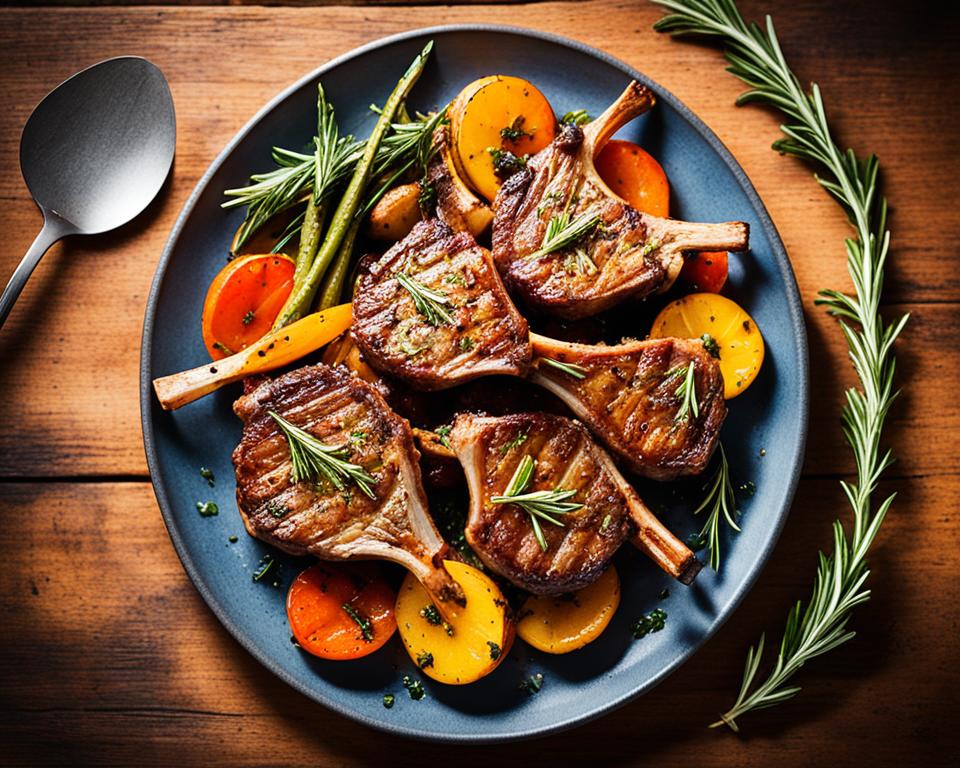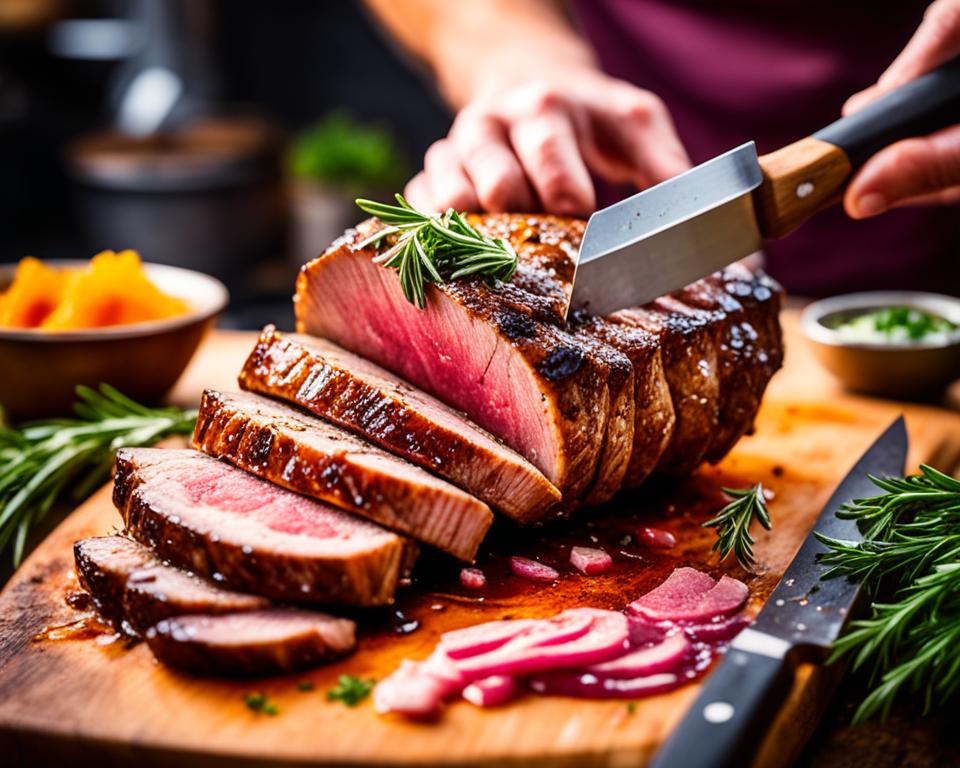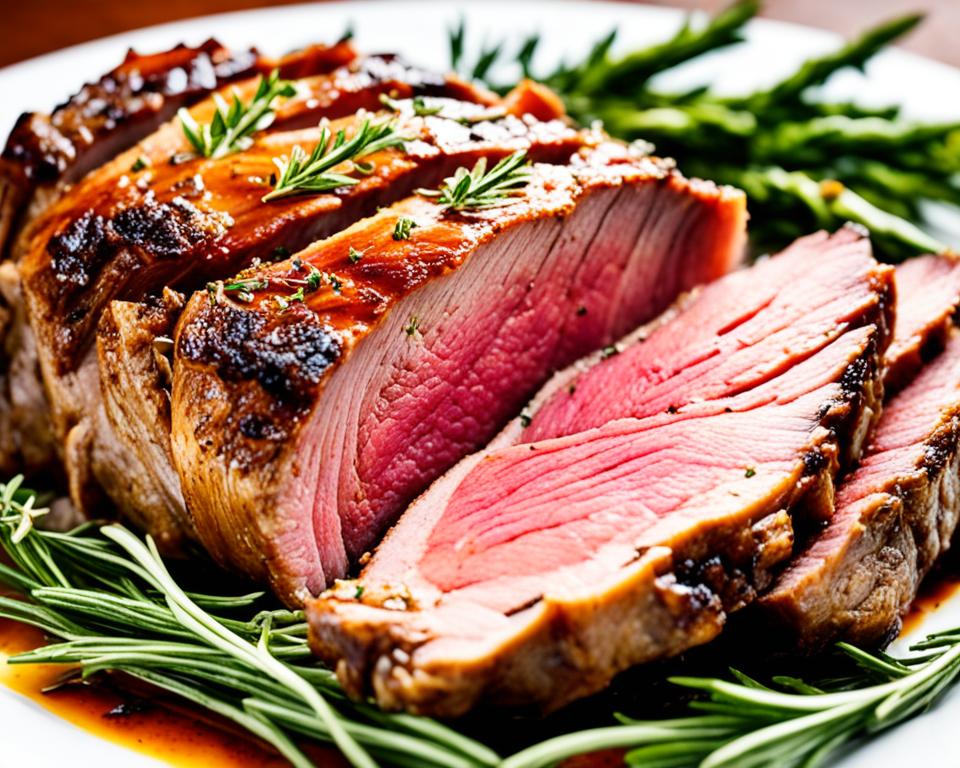Gigot d’Agneau is a treasured French dish known for its succulent roasted leg of lamb. For centuries, it has been a mainstay of French cuisine, offering rich and flavorful meat. It’s ideal for special gatherings or a laid-back Sunday meal. This complete guide will show you how to make a delectable gigot d’agneau. We’ll dive into its history, cooking methods, and must-have side dishes, making it a culinary masterpiece.
Read interesting things at : vsocan
Key Takeaways
- Gigot d’Agneau is a classic French dish featuring a roasted leg of lamb
- This preparation has been a staple in French cuisine for generations
- The dish showcases the rich, flavorful meat of the lamb leg
- Gigot d’Agneau is perfect for special occasions or cozy Sunday dinners
- This guide will explore the history, preparation techniques, and classic accompaniments of gigot d’agneau
What is Gigot d’Agneau?
Gigot d’Agneau means “leg of lamb” in French. It’s a special dish loved in France. Generations have savored its succulent taste.
Farmers and home cooks in rural France started this tradition. They would slow-roast young spring lamb legs. As a result, a delicious and tender meal is created for everyone to enjoy.
Definition and Origins of the French Lamb Dish
The gigot d’agneau is a classic in French cuisine. It highlights the lamb leg’s juicy meat. French culture values good, seasonal foods. And this dish is a perfect example of that.
The lamb leg, with its caramelized outside and juicy inside, is a true pleasure. It’s a delight that engages all the senses.
Popular Cuts of Lamb Used for Gigot d’Agneau
Choosing the right cut of lamb is key for gigot d’agneau. The leg cut, or “lamb leg” in French, is often picked. It balances tenderness and flavor well for the long roasting process.
| Lamb Cut | Characteristics | Typical Use in Gigot d’Agneau |
|---|---|---|
| Leg of Lamb | Tender, well-marbled, and flavorful | The most common and preferred cut for traditional gigot d’agneau preparation |
| Lamb Loin | Extremely tender, lean, and mild in flavor | Less commonly used for gigot d’agneau, as the loin may dry out during the long roasting process |
| Lamb Shoulder | Relatively tough, with a richer, more robust flavor | Occasionally used in regional or rustic variations of gigot d’agneau, often slow-braised or stewed |
The leg of lamb truly stands out in gigot d’agneau. Yet, different cuts can be used too. They offer unique flavors in various versions of the dish.
Preparing the Lamb for Roasting
Getting the gigot d’agneau just right means starting off with the perfect lamb leg. You want to make sure the meat you pick is top-notch, fresh, and flawless. After you’ve dried off the lamb, season it well.
A mix of garlic, rosemary, thyme, and black pepper is a favorite for gigot d’agneau. This step sets the stage for a delicious roast.
Seasoning and Marinating Techniques
For a flavorful kick, marinate the leg of lamb. Use tasty herbs, spices, and something tangy like wine or citrus. This special bath not only flavors the lamb but also makes it tender.
Trussing and Tying the Lamb Leg
Next, before the oven, there’s trussing and tying to do. Tying the lamb up keeps it neat and ensures even cooking. It’s about using string to hold the lamb trussing in place. This way, the roasting lamb stays moist and looks great.
Roasting the Gigot d’Agneau
So, you’ve got the roasted lamb leg all set. Now, it’s time to roast it just right. Set your oven to a high heat, usually 400°F (200°C), and let it get toasty. This high heat will help seal the lamb’s outside and keep the meat juicy inside. Next, put the trussed lamb leg in a roasting pan and pop it in the oven.
Oven Temperature and Cooking Times
The perfect lamb oven temperature is high enough to give the meat a tasty crust. But it should still keep the inside soft and moist. Cook your lamb around 20-25 minutes for every pound. If you want it to be pink in the middle, check that it’s 130-140°F (55-60°C) inside.
Basting and Resting the Roasted Lamb
To get an even coat, keep spooning pan juices over the lamb while it roasts. This gives the lamb a shiny, tasty skin. After the lamb is cooked just how you like it, take it out. Let it sit for 15-20 minutes before cutting. This break lets the juices spread evenly, making the gigot d’agneau sweet and tender.
Classic French Accompaniments
Gigot d’Agneau is the respected French roasted leg of lamb. It’s often enjoyed with classic sides, like lamb sauces and gravies. These pair well with the lamb’s tender, succulent taste.
Flavorful Sauces and Gravies
A key accompaniment to French lamb is a pan sauce. Made from roasting pan drippings, it’s simple yet flavorful. You can jazz it up with Dijon mustard or red wine for a rich taste that complements the roasted lamb leg.
A red wine reduction sauce offers a richer option. It’s made by simmering the lamb juices with a bold red wine. This classic sauce enriches the lamb’s flavors, creating a memorable dish.
Vegetable Side Dishes
French lamb dishes often come with varied vegetable side dishes. Roasted root vegetables like potatoes, carrots, and onions are common. They absorb the lamb’s juices, enhancing the meal.
Also popular are green beans or a salad. These add a fresh, light taste that balances the lamb’s richness. By including these sides, the gigot d’agneau turns into a complete, satisfying meal.
Health Benefits of Lamb
Lamb is a tasty and adaptable meat with many health benefits. It’s a top lean protein source, rich in iron, zinc, and vitamin B12. These are key in keeping us healthy by boosting our immune system, helping our brain work better, and giving us energy.
Lamb’s nutritional value makes it a great pick for those wanting a healthy protein. It’s full of high-quality protein, needed for fixing our tissues and building muscles. Lamb also brings omega-3 fatty acids, good for our heart and fighting off inflammation.
Eating lamb can really benefit your health and wellness. Whether it’s a leg of lamb or other lamb meals, this tasty, nutrient-packed meat can change your diet for the better. Knowing about the health perks of lamb helps us choose smartly when adding it to our meals.
Gigot d’Agneau for Special Occasions
Gigot d’Agneau is a star at special gatherings in French culture. It’s especially popular in the spring and at Easter. The taste of the roasted gigot d’agneau is both rich and succulent, perfect for Easter events, spring meals, or fancy dinner parties.
Easter and Spring Celebrations
Springtime is when gigot d’agneau truly shines. This dish is loved in France and is a top pick for Easter. At these feasts, families come together to enjoy the tender, flavorful spring lamb. Its elegant look and delicious taste match the happiness of the holiday perfectly.
Gourmet Dinner Party Ideas
The gigot d’agneau is not just for Easter. It’s also great for dinner parties or elegant events. This dish is known for bringing sophistication and finesse to any occasion. It can be the star of a meal or part of a bigger menu, adding an elegant touch to fancy lamb recipes or a lamb dinner party.
Gigot d’Agneau
The classic gigot d’agneau is a favorite in French cooking. It comes in many regional and personal forms. For example, in different parts of France, people season the lamb with various herb blends. This could include herbes de Provence or a mix of garlic, rosemary, and thyme. Some might even slow-cook the lamb at a low temperature to make it extra tender.
Variations and Regional Styles
France’s regions put their own twist on gigot d’agneau. In the Provence area, they use aromatic herbes de Provence on the lamb. Meanwhile, in Burgundy, they add a special rich red wine sauce to the roast. In Normandy, it’s more about local flavors. They serve the leg of lamb with a creamy apple cider sauce.
Leftovers and Repurposing Roasted Lamb
Making a gigot d’agneau leads to lots of leftover lamb. You can turn these into many yummy dishes. Think of lamb stews, shepherd’s pies, lamb sandwiches, or lamb salads. These meals not only taste good but also show how flexible French cooking can be.
Expert Tips and Techniques
For the best gigot d’agneau, listen to experienced chefs. They recommend choosing the right lamb cut. Also, how you cook it affects the taste greatly. Achieving the perfect doneness is crucial for a flavorful roasted leg of lamb.
Choosing the Right Cut of Lamb
Choose a lamb cut that looks good for your gigot d’agneau. Look for a leg that is firm and has a good shape. Make sure it doesn’t have any spots or discoloration. In general, the bone-in leg is better. It keeps the meat moist better when roasting.
Achieving the Perfect Doneness
To make your gigot d’agneau juicy and tender, cooking it right is key. Always use a meat thermometer. It will help you cook the lamb to the right temperature, around 130°F to 135°F. This gets the meat from medium-rare to medium, with a lovely pink color inside.
Traditional French Lamb Roast: A Culinary Journey
The gigot d’agneau roast is a big part of French food history. Families have shared this dish for years during big gatherings and holidays. It shows how much the French love good, seasonal food.
This dish started in the countryside of France. Back then, people cooked the leg of a young lamb very slowly. They cooked it this way to keep it juicy and full of flavor. Over time, this way of cooking lamb has changed but remains an important part of French food culture.
Even today, the traditional French lamb roast is very popular. People in France and all over the world love it. This dish symbolizes the best of French cooking. It’s all about using the best ingredients and traditional ways of cooking.

The gigot d’agneau is a key part of French culinary tradition. It keeps impressing people who love good food all around the globe.
Pairing Gigot d’Agneau with Wines
Gigot d’Agneau is perfect with many wine types. You can pick wines that bring out the flavors. It makes the meal taste even better. You can choose strong reds or light whites to go with this French lamb dish.
Red Wine Recommendations
If you like red wine, try Bordeaux, Côtes du Rhône, or Cabernet Sauvignon. These have right richness to match the lamb. They also add to the sweet taste. Other good choices for wine pairing with gigot d’agneau are Malbec, Merlot, and Syrah.
White Wine Suggestions
Red wines are traditional, but whites can work too. A Chardonnay or Sauvignon Blanc can balance the richness. They offer a fresh taste. For something different, try a rich Viognier or Rhône white blend. They bring a whole new level of flavor with red wines for lamb.
Choosing the right wine is about what you like and how your lamb is cooked. Mix and match to find the perfect match. This makes your meal even more enjoyable.
Adapting the Recipe for Modern Diets
The way we eat is changing, and so is the food we enjoy. Take the classic gigot d’agneau, a French favorite. It’s being transformed to meet today’s diverse dietary needs. For those on a gluten-free or Paleo diet, or if you prefer vegetarian and vegan meals, there are new paths to savor this rich and tasty dish.
Gluten-Free and Paleo Options
If you avoid gluten or live the Paleo way, adjusting the traditional recipe is simple. Just skip the breadcrumbs and flour in the sauces. Instead, enhance the lamb‘s flavors with herbs, garlic, and spices. Serve your roasted leg of lamb with sides like roasted veggies, mashed sweet potatoes, or a crisp salad. This will keep your meal both delicious and diet-friendly.
Vegetarian and Vegan Alternatives
The gigot d’agneau may be a star in French cuisine, but it’s not just for meat-eaters anymore. There are many tasty vegetarian and vegan twists available. Try dishes made with portobello mushrooms, lentil “meatballs,” or a hearty vegan roast. Pair these with the classic French sides for a complete and delightful meal.
The Art of Carving Gigot d’Agneau
Carving a great gigot d’agneau marks the end of a culinary adventure. It needs skill and the right technique. First, let the lamb leg rest for 15-20 minutes. This helps the meat retain its juices, making it easier to carve roasted lamb.
Start carving with a sharp knife, cutting against the grain. This creates thin, even slices, showing off the lamb’s moisture. Keep a steady hand, slicing smoothly. This ensures your carving is neat and attractive.
Think about how thick you want your slices. For a fancy look, go for thin slices. A casual event might call for thicker slices. Place the slices nicely on a plate. This highlights the lamb’s appeal.
Make the dish look even better by adding fresh herbs on top. You can use rosemary or thyme. And don’t forget a tasty sauce. This makes everything look and taste great, creating a memorable meal for your guests.
| Tips for Carving Gigot d’Agneau | Key Steps |
|---|---|
| Allow for Proper Resting | Let the roasted lamb leg rest for 15-20 minutes before carving, allowing the juices to redistribute. |
| Utilize a Sharp Carving Knife | Use a sharp, high-quality carving knife to ensure clean, precise slices. |
| Slice Against the Grain | Cut the lamb leg slices across the grain for the most tender and juicy outcome. |
| Consider Slice Thickness | Adjust the slice thickness based on the desired presentation and serving style. |
| Enhance the Presentation | Garnish the carved lamb with fresh herbs and serve with a flavorful sauce or gravy. |
By using these proper lamb carving technique tips, your gigot d’agneau can become a beautiful, tasty centerpiece. It shows why this traditional French dish is so loved.

Exploring Other Classic French Lamb Dishes
The gigot d’agneau is a famous French lamb dish. Yet, it’s not the only one. There are more tasty lamb meals in French cooking. For example, the Navarin d’Agneau and Côtelettes d’Agneau are also quite popular.
Navarin d’Agneau (Lamb Stew)
The Navarin d’Agneau is a warm, comforting lamb stew from France. It highlights the delicious, lamb. Cooks braise lamb shoulder or leg in a tasty broth. They add veggies like potatoes, carrots, and peas. The stew becomes a rich, delicious lamb stew. It’s often eaten with crispy bread or soft mashed potatoes.
Côtelettes d’Agneau (Lamb Chops)
The Côtelettes d’Agneau is a popular dish of lamb chops. They are either grilled or cooked in a pan. These tender lamb chops are usually seasoned with herbs and spices. This brings out the best of the lamb‘s flavor. You can eat them with roasted veggies, Dijonnaise sauce, or mashed potatoes.
The gigot d’agneau, Navarin d’Agneau, and Côtelettes d’Agneau show how diverse French lamb recipes are. They offer a mix of tastes and ways to enjoy them. They are great for any type of meal, from simple to fancy.
Troubleshooting Common Cooking Issues
Even those who cook a lot might find making gigot d’agneau tough. To get it right, knowing and fixing some typical lamb cooking problems during the roasting is key.
Troubleshooting roasted lamb often involves overcooking. This can make the meat dry and hard. To avoid this, keep an eye on the meat’s temperature. Take it out of the oven at the right time, about 130°F (55°C) for medium-rare. Let it sit for 15-20 minutes before slicing. The heat will even out, and the meat will be juicier.
But, sometimes you can end up with a lamb that’s cooked differently inside and outside. To solve this common lamb cooking problem, try searing the lamb in a pan first. This helps the heat spread better. Also, baste the lamb with its own juices or flavorful liquids while cooking to help it cook evenly.
If your main worry is a flavorless or dry lamb, spice up your seasoning game. Play around with various herbs and spices. Make sure to coat the lamb well before cooking. Basting with tasty liquids like broth or wine can also boost the flavor.
Follow these tips to tackle common lamb cooking problems and achieve a perfect gigot d’agneau every time. A bit of practice and attention to detail will make even the most stubborn lamb cooking problems simple to fix.
Best Somtam Thai in Bangkok: Authentic Thai Green Papaya Salad
Conclusion
Gigot d’Agneau, or the French roasted leg of lamb, is a dish that’s been loved for ages. It’s known for its full flavor and tenderness. Prepared through a special roasting method, it makes a delicious meal for special events or when families gather.
This dish is important as it shows France’s farming roots and love for fine, fresh food. Initially from France’s countryside, now it’s enjoyed by many. Gigot d’agneau is a true mark of French cooking, showing their skill and tradition over time.
Saying goodbye to the roasted lamb leg, we see its beauty is not just in how it tastes. It’s also in the blend of tradition, skills, and local influences. For chefs and cooks at home, making the perfect gigot d’agneau is a rewarding journey. It’s a chance to enjoy and understand the heart of French food.


